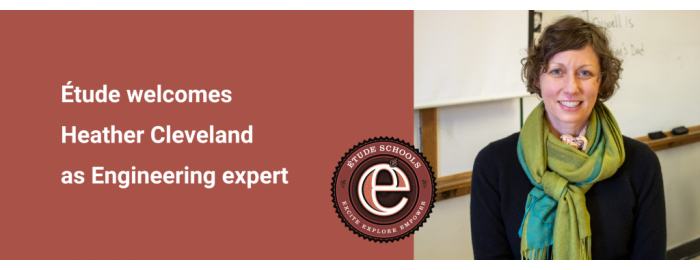
Up to now, STEM students at Étude High School have immersed themselves in robotics and traditional engineering themes. This semester, things are a little different.
Instead of what they might have expected, engineering students are learning principles of high-level engineering and how they relate to the world around them.
Instructor Heather Cleveland has had several careers before this one. Now the owner of the Green Bicycle Co. in Sheboygan, an urban planning/community development organization, Cleveland has a degree in civil engineering and worked for 15 years in the environmental engineering field..
Cleveland’s path to the engineering classroom at ÉHS was not straightforward, she said. She took all the STEM classes she could take in high school: pre-calculus, drafting, science, etc., but she wasn’t ready for the rigor of pursuing an engineering degree..
“Nothing prepared me for what was coming when it comes to (post-secondary) engineering classes, like calculus, statics, fluid mechanics and dynamics,” she said. “I wanted the students in this class to have heard those terms. I believe in tying it to the environment, something they’re passionate about as young people. The type of engineering I’m teaching is about being human.”
In Cleveland’s environmental engineering class, students (everyone from freshmen to seniors) discuss current events related to the environment and work at tying that to engineering concepts.
The idea, she said, is to give students the most well-rounded taste of what’s ahead as possible, because if they go on to study the subject later they’ll need a better foundation than she had.
“There are basic classes everybody takes regardless of engineering specialty,” Cleveland said. “Core foundational classes, whether they go on to environmental, civil, structural, electrical, chemical engineering, etc., they all have a foundation. I’m tying it into things they recognize to understand the application so when the time comes, they know what path to take.”
Cleveland was a past executive director at Nourish, and her degree in urban planning sparked an interest in community engagement, she said. She was also briefly on the Étude Group board, which cemented her commitment to the Étude educational model.
“I believe in it,” she said. “I believe in project-based work, and I’m familiar with the Exhibitions of Learning. My challenge is, how can I weave that in?”
Though it’s a brand-new class at the high school, Cleveland started right away planning ways to incorporate interdisciplinary lessons, including science and math, and even writing. In fact, students are currently working on individual research projects, using all their language arts skills along with what they’re learning about environmental engineering.
Cleveland is working with language arts teacher Addie Degenhardt to learn the subtleties of the Étude method, and honing her skills in the workaday teaching tasks of grading, attendance, classroom structure, etc.
Planning for the end-of-the year group project is well underway, and Cleveland said she is looking forward to ongoing partnerships with her fellow teachers.
“I’m looking for collaboration,” she said. “The math and science folks – we’re going to speak the same language.”
Cleveland said she has high hopes for her engineering students this semester.
“I want them to understand engineering concepts and be able to explain them,” she said. “I want them to connect engineering with equations, not be afraid of them, and I want them to have a glimpse into what engineering in college and the community looks like.
“I want the students to see themselves as problem-solvers and to know that they can make a difference as individuals and as future engineers,” Cleveland said. “I’m doing what I wish would’ve been done for me.”

